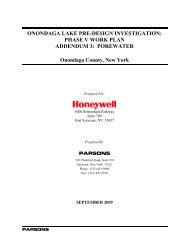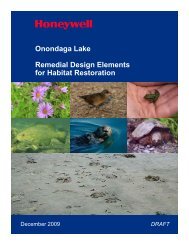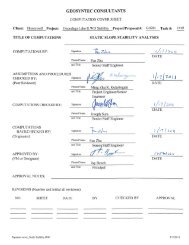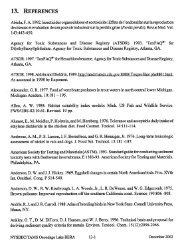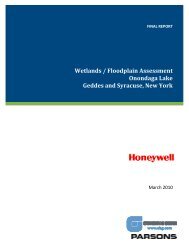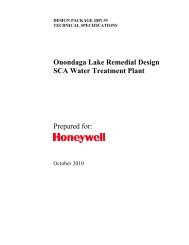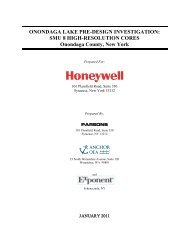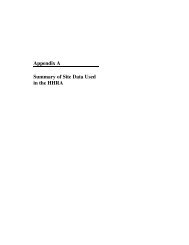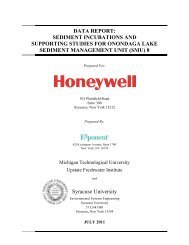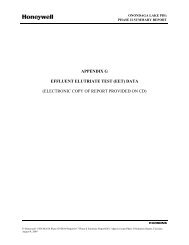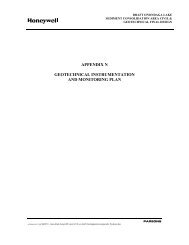Phase 1B Underwater Archaeological Report for the Onondaga ...
Phase 1B Underwater Archaeological Report for the Onondaga ...
Phase 1B Underwater Archaeological Report for the Onondaga ...
You also want an ePaper? Increase the reach of your titles
YUMPU automatically turns print PDFs into web optimized ePapers that Google loves.
FINAL<br />
<strong>Phase</strong> IB <strong>Underwater</strong> <strong>Archaeological</strong> Resources <strong>Report</strong> <strong>for</strong> <strong>Onondaga</strong> Lake Superfund Site<br />
Research Results<br />
A17-2 (inshore) and A17-1 (outer) are two identical spud barges in 1 to 3 ft (0.3 to 0.9m) of water. The<br />
barges’ sides, ends, bottom and internal structural members are present, while its deck and deck<br />
features are no longer extant. Approximately eighty percent of <strong>the</strong> original fabric of <strong>the</strong> barges remains.<br />
Plans <strong>for</strong> shoreline improvement include placing riprap in <strong>the</strong> area of A17-2.<br />
The focus of <strong>the</strong> field work at <strong>the</strong> A17 barges was on A17-2 because <strong>the</strong> plans <strong>for</strong> shoreline stabilization<br />
had <strong>the</strong> most potential to adversely impact that resource. Approximately one half of <strong>the</strong> barge could be<br />
examined in shallow water; <strong>the</strong> western half is buried under <strong>the</strong> shoreline and covered with phragmites.<br />
A17-1 was also photo-documented during this investigation; its identical construction to A17-1 and<br />
complete exposure allows <strong>for</strong> data extrapolation.<br />
A17-1 is 97ft (29.6m) in length and 34ft (10.4m) in beam. The length on A17-2 is also 97ft (29.6m), and<br />
<strong>the</strong> beam is assumed to be identical to A17-1 at 34ft (10.4m). Each vessel contains two outboard spud<br />
holders opposite one ano<strong>the</strong>r, approximately 36in (91cm) square (Figure 105). The eastern ends of <strong>the</strong><br />
barges are vertical with vertical planking. The sides are vertical, built plank-on-frame. The western end,<br />
opposite <strong>the</strong> spud holders, is raked with transverse planking. The hull structures consisted of planking,<br />
floors, and stringers; <strong>the</strong>se three, all connected, made up <strong>the</strong> entire depth of hull. The flywheel and<br />
o<strong>the</strong>r machinery are evident in A17-1, and <strong>the</strong> mounting brackets <strong>for</strong> <strong>the</strong> flywheel are visible on A17-2<br />
(Figure 104).<br />
The western end of A17-1 had a mound of concrete immediately adjacent to it (Figure 106). Inspection<br />
of <strong>the</strong> concrete suggested that it was <strong>for</strong>med by pouring it into that end of <strong>the</strong> barge as a counterweight<br />
<strong>for</strong> <strong>the</strong> spuds and machinery on <strong>the</strong> o<strong>the</strong>r end. It was likely pulled out and dumped so that <strong>the</strong> vessel<br />
could be pulled into shallow water next to A17-2.<br />
The two barges at A17 are part of a larger, more complex site. Immediately north and east of A17-1 and<br />
A17-2 <strong>the</strong>re are at minimum two additional sunken barges. These sites are almost entirely obscured by<br />
extremely dense aquatic vegetation. Additionally, <strong>the</strong>re are a series of pilings located offshore to <strong>the</strong><br />
east of A17-1 and A17-2. It remains unclear whe<strong>the</strong>r <strong>the</strong> deposition of <strong>the</strong> offshore barges and A17<br />
correspond to <strong>the</strong> pilings, or if <strong>the</strong>y are related to one ano<strong>the</strong>r.<br />
There is no evidence to suggest that spud barges of this type were constructed on <strong>Onondaga</strong> Lake; <strong>the</strong><br />
barges were likely constructed elsewhere and brought to <strong>the</strong> lake. No boat of this size could get to<br />
<strong>Onondaga</strong> Lake until <strong>the</strong> opening of <strong>the</strong> enlarged Barge Canal in 1918. With <strong>the</strong> closure of <strong>the</strong> Lake<br />
View Point resort two years’ prior in 1916, it is improbable that <strong>the</strong> barges were connected to <strong>the</strong> resort.<br />
It is unclear <strong>the</strong> purpose of <strong>the</strong>se barges’ deposition, though we know that <strong>the</strong>y were intentionally run<br />
into shallow water at <strong>the</strong> end of <strong>the</strong>ir working life. Although <strong>the</strong>re is no historical in<strong>for</strong>mation to confirm<br />
it, <strong>the</strong> barges may have been brought to this area to aid in <strong>the</strong> solvay waste deposition on shore,<br />
perhaps to provide structural support <strong>for</strong> <strong>the</strong> material placement. What is certain is that since A17-2 is<br />
buried in <strong>the</strong> material, <strong>the</strong> barge deposition occurred be<strong>for</strong>e <strong>the</strong> end of <strong>the</strong> solvay waste deposits in<br />
1943. This limits <strong>the</strong> barges’ sinking to between 1918 and 1943.<br />
156



